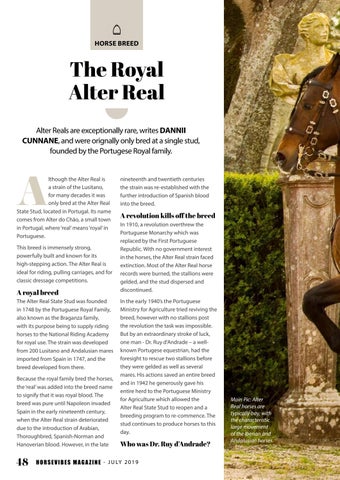HORSE BREED
The Royal Alter Real Alter Reals are exceptionally rare, writes DANNII CUNNANE, and were orignally only bred at a single stud, founded by the Portugese Royal family.
A
lthough the Alter Real is a strain of the Lusitano, for many decades it was only bred at the Alter Real State Stud, located in Portugal. Its name comes from Alter do Chão, a small town in Portugal, where ‘real’ means ‘royal’ in Portuguese. This breed is immensely strong, powerfully built and known for its high-stepping action. The Alter Real is ideal for riding, pulling carriages, and for classic dressage competitions.
A royal breed The Alter Real State Stud was founded in 1748 by the Portuguese Royal Family, also known as the Braganza family, with its purpose being to supply riding horses to the National Riding Academy for royal use. The strain was developed from 200 Lusitano and Andalusian mares imported from Spain in 1747, and the breed developed from there. Because the royal family bred the horses, the ‘real’ was added into the breed name to signify that it was royal blood. The breed was pure until Napoleon invaded Spain in the early nineteenth century, when the Alter Real strain deteriorated due to the introduction of Arabian, Thoroughbred, Spanish-Norman and Hanoverian blood. However, in the late
48
nineteenth and twentieth centuries the strain was re-established with the further introduction of Spanish blood into the breed.
A revolution kills off the breed In 1910, a revolution overthrew the Portuguese Monarchy which was replaced by the First Portuguese Republic. With no government interest in the horses, the Alter Real strain faced extinction. Most of the Alter Real horse records were burned, the stallions were gelded, and the stud dispersed and discontinued. In the early 1940’s the Portuguese Ministry for Agriculture tried reviving the breed, however with no stallions post the revolution the task was impossible. But by an extraordinary stroke of luck, one man - Dr. Ruy d’Andrade – a wellknown Portugese equestrian, had the foresight to rescue two stallions before they were gelded as well as several mares. His actions saved an entire breed and in 1942 he generously gave his entire herd to the Portuguese Ministry for Agriculture which allowed the Alter Real State Stud to reopen and a breeding program to re-commence. The stud continues to produce horses to this day.
Who was Dr. Ruy d’Andrade?
H O R S E V I B E S M A G A Z I N E - J U LY 2 0 1 9
Main Pic: Alter Real horses are typically bay, with the characteristic large movement of the Iberian and Andalusian horses.














